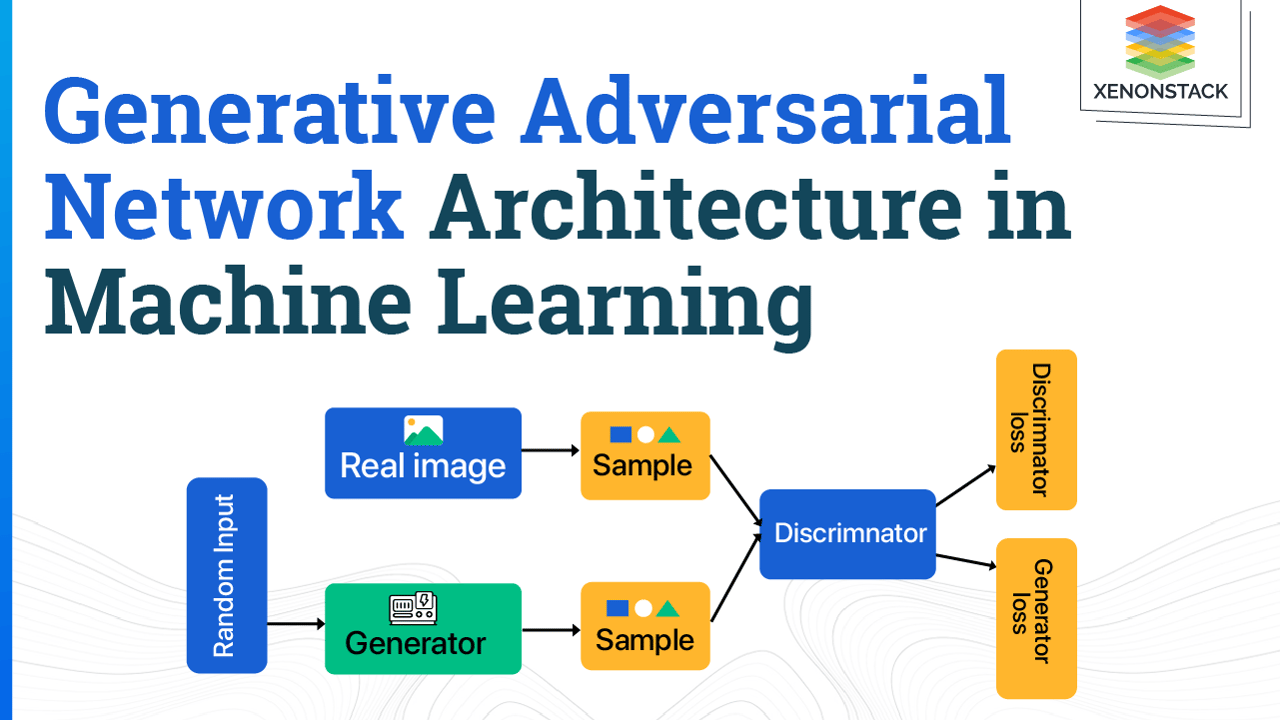
In recent years, the field of artificial intelligence has witnessed remarkable advancements, especially in the domain of Generative Models. Among these groundbreaking architectures, Generative Adversarial Networks (GANs) have emerged as a pinnacle of innovation, demonstrating their profound ability to generate realistic and captivating outputs. This blog post aims to delve deep into the captivating world of GAN architecture, exploring its intricate components, evolutionary journey, vast applications, inherent challenges, and promising future directions.
Exploring GAN Architecture and Its Role in AI Innovation
Generative Adversarial Networks (GANs) represent a revolution in the field of artificial intelligence. They comprise two primary components: a generator and a discriminator. The generator harnesses the power of latent random vectors, skillfully employing a series of complex transformations to produce outputs that resemble real data. On the other hand, the discriminator acts as an astute critic, meticulously analysing the generated samples along with the genuine data to discern their authenticity. Through an adversarial interplay, these components engage in a competitive training process, resulting in the refinement and evolution of both networks over time.
With the rapid growth of Computer Vision on Edge and its Applications, GANs are becoming increasingly important in areas that demand real-time image generation and enhancement. From Biomedical Image Analysis and Diagnostics, where GANs assist in synthesizing medical scans for better disease detection, to Automating Financial Document Processing with Computer Vision, where they enhance OCR-based text extraction, these architectures are revolutionizing industries far beyond traditional image generation.
Evolution of GAN Architectures: From Vanilla GANs to Advanced Models
The evolutionary journey of GAN architectures has been nothing short of remarkable. The initial vanilla GAN laid the foundation for subsequent advancements, introducing the fundamental principles of adversarial training and showcasing the immense potential of generative models. Since then, a plethora of GAN variations have been developed, each building upon the achievements of its predecessors and addressing specific challenges. Noteworthy advancements include DCGAN (Deep Convolutional GAN), which incorporated convolutional layers to generate high-resolution images and enhance training stability, and CGAN (Conditional GAN), which introduced conditioning to allow for controlled generation based on additional input.
Furthermore, the emergence of CycleGAN revolutionized the field by enabling style transfer and domain adaptation without the need for paired training data. StyleGAN introduced the concept of disentangled representations, empowering users to manipulate various aspects of generated images, such as styles, while maintaining exceptional visual quality. Additionally, progressive GANs adopted a progressive training methodology, starting from low-resolution images and progressively increasing complexity, leading to improved stability and the generation of high-quality outputs.
The Mechanics of GAN Architecture and Training
Generative Adversarial Networks (GANs) are a revolutionary class of generative models that have garnered significant attention in the field of artificial intelligence. GANs employ a unique architecture that consists of two primary components: a generator and a discriminator. The underlying idea behind GANs is to create a dynamic interplay between these two components, allowing them to learn from each other and improve iteratively.
GAN Components: Generator and Discriminator
On the other hand, the discriminator acts as a binary classifier that distinguishes between real and fake data samples. It is trained to differentiate between the generated samples from the generator and real data from a training dataset. The discriminator's objective is to accurately classify the inputs as real or fake, thereby improving its ability to discern between the two.
Training Process: Adversarial Interplay
The training process of GANs involves an adversarial interplay between the generator and the discriminator. Initially, both the generator and discriminator are randomly initialized. The generator generates synthetic samples, while the discriminator tries to accurately classify them.
Iterative Learning and Feedback
During training, the generator strives to produce samples that can deceive the discriminator, making them appear as genuine as possible. Simultaneously, the discriminator aims to improve its classification accuracy, correctly identifying real and fake samples. As both components learn and adapt, they engage in a competitive process, continuously challenging each other.
The training process typically involves iterations or epochs, where a mini-batch of real and fake samples is fed into the discriminator. The discriminator provides feedback to the generator, indicating how well the generated samples resemble real data. This feedback guides the generator's learning, allowing it to refine its output to fool the discriminator more effectively.
Achieving Equilibrium
Through this iterative process, the generator becomes more proficient in generating realistic samples, while the discriminator becomes more adept at differentiating between real and fake data.
The ultimate objective of training GANs is to find an equilibrium state where the generator produces samples that are virtually indistinguishable from real data, and the discriminator struggles to classify them accurately. Achieving this equilibrium indicates that the generator has successfully learned the underlying distribution of the training data and can generate highly realistic samples.
The adversarial interplay and iterative nature of GAN training make it a powerful technique for generating realistic and creative outputs.
Breakthroughs in GAN Variants and Their Role in Computer Vision
Vanilla GAN
The Vanilla GAN, proposed by Ian Good fellow and his colleagues in 2014, laid the foundation for subsequent advancements in the field. It introduced the concept of adversarial training, where a generator and a discriminator engage in a two-player minimax game. The generator learns to generate synthetic samples that resemble real data, while the discriminator learns to distinguish between real and fake samples.
Despite its simplicity, the Vanilla GAN faced challenges such as training instability and mode collapse, where the generator fails to explore the entire target distribution. However, it provided a solid starting point for further research and innovation.
DCGAN: Deep Convolutional GAN
To address the limitations of the Vanilla GAN and improve the quality of generated images, Radford et al. proposed the Deep Convolutional GAN (DCGAN). DCGAN introduced convolutional layers in both the generator and discriminator architectures, enabling the generation of high-resolution and visually appealing images.
By leveraging the power of convolutional neural networks (CNN's), DCGAN improved training stability and facilitated the generation of more realistic images. It became a seminal work that established the use of CNN's in GAN architectures and laid the groundwork for subsequent advancements.
CGAN: Conditional GAN
Conditional GAN (CGAN), introduced by Mirza and Osindero, extended the capabilities of GANs by incorporating additional conditioning information during the training process. In CGAN, both the generator and discriminator receive additional input, such as class labels or image descriptions, which allows for controlled generation of samples based on specific attributes.
CGAN opened up new possibilities for generating samples that belong to specific classes or exhibit desired characteristics. It found applications in tasks such as image synthesis with specific attributes and text-to-image generation.
CycleGAN: Cycle-Consistent GAN
CycleGAN, proposed by Zhu et al., introduced a novel approach for learning mappings between two different domains without the need for paired training data. It leveraged the concept of cycle consistency, where the generator learns to translate samples from one domain to another and back, while ensuring that the reconstructed samples resemble the original input.
By allowing unsupervised learning of domain mappings, CycleGAN facilitated style transfer, domain adaptation, and artistic transformations. It proved particularly useful in tasks such as image style transfer and transforming images between different artistic domains.
StyleGAN: Style-Based GAN
StyleGAN, introduced by Karras et al., revolutionized the field of GANs by enabling fine-grained control over various aspects of generated images. It introduced the concept of disentangled representations, allowing separate control over latent variables related to different image attributes, such as pose, lighting, and facial features.
StyleGAN achieved exceptional visual quality and realism by using a two-step generation process. First, a coarse-resolution image is generated, and then progressively more detailed features are added. This approach resulted in highly realistic and diverse images, with applications ranging from face synthesis to art generation.
Progressive GAN
Progressive GAN, proposed by Karras et al., addressed the challenge of generating high-resolution images by adopting a progressive training methodology. It started with low-resolution images and gradually increased the complexity by adding more layers to the generator and discriminator.
This progressive training process improved stability and allowed for the generation of high-quality images with fine details. Progressive GANs demonstrated superior performance in image synthesis and contributed to the advancement of GAN architectures.
The evolution of GAN architectures has significantly expanded the capabilities of generative models, enabling the generation of high-quality, diverse, and controlled outputs. These advancements have found applications in various fields, including image synthesis, style transfer, and domain adaptation. As the field continues to evolve, researchers strive to overcome challenges such as training stability, mode collapse, and evaluation metrics, ultimately unlocking the full potential of GAN architectures.
Real-World Applications of GANs in Computer Vision and AI
Image Synthesis and Editing
Generative Adversarial Networks (GANs) revolutionize image synthesis by generating highly realistic images and offering advanced editing capabilities. GANs enable tasks like image in painting, where missing parts of an image are seamlessly filled, and attribute manipulation, allowing users to modify specific features of an image. These advancements have significant implications for computer graphics, advertising, and various creative industries, enhancing visual quality and expanding the possibilities of digital image manipulation.
Text-to-Image Generation
The combination of GANs with natural language processing techniques has led to remarkable progress in text-to-image generation. By interpreting textual descriptions, GANs can generate corresponding images, bringing written concepts to life. This technology holds tremendous potential for visual storytelling, allowing authors and artists to translate their narratives into visual representations. Additionally, text-to-image generation finds applications in e-commerce, where product descriptions can be transformed into appealing visual representations, enhancing the online shopping experience.
Video Generation and Prediction
GAN architectures have extended their capabilities from still images to the dynamic realm of videos. GANs can generate and predict video sequences, enabling tasks such as video synthesis, deepfake detection, and video game development. Video synthesis involves the generation of new video content based on training data, providing opportunities for creating realistic and engaging videos. GANs also play a crucial role in deepfake detection, helping to identify and combat the manipulation of videos using artificial intelligence techniques. Furthermore, video game developers leverage GANs to create lifelike characters, realistic animations, and immersive environments, enhancing the overall gaming experience.
Domain Adaptation and Style Transfer
GANs have emerged as powerful tools for domain adaptation and style transfer in various creative domains. They can transfer styles between different domains, allowing the transformation of images into different artistic styles, such as turning photographs into paintings or adapting images from one domain to another. This capability has significant applications in design, fashion, and advertising, where the ability to manipulate and adapt styles opens up new creative possibilities and enables unique visual expressions.
Challenges in GAN Training: Mode Collapse, Stability, and Evaluation
Mode Collapse
A significant challenge in GAN training is mode collapse, where the generator fails to capture the full diversity of the target distribution, resulting in limited variations in generated samples. Researchers have proposed techniques such as regularisation methods, game-theoretic approaches, and architectural modifications to mitigate mode collapse and encourage the production of diverse and high-quality outputs, ensuring that GANs capture the full richness of the underlying data distribution.
Training Instability
GAN training is notorious for its inherent instability, characterized by oscillating or diverging losses during the training process. This instability can hinder convergence to an optimal equilibrium point, making training GANs a non-trivial task. To address this challenge, researchers have proposed various strategies, including adjusting learning rates, using different optimization algorithms, employing specific loss functions like Wasserstein distance, and utilising stabilisation techniques like feature matching and gradient penalty. These approaches aim to improve training stability and promote successful GAN convergence.
Evaluation and Metrics
Evaluating the performance of GANs is a complex task due to the absence of well-defined objective metrics. Traditional evaluation metrics like Inception Score and Frechet Inception Distance provide partial insights but have limitations in capturing the full quality and diversity of generated samples. As a result, researchers are actively exploring new evaluation techniques, including perceptual-based evaluation, user studies, and the development of novel metrics that align with human perception and subjective judgement. This ongoing research aims to establish comprehensive and reliable evaluation frameworks for assessing GAN performance accurately.
Ethical Considerations
With the rapid advancement of GAN technology, ethical considerations arise regarding privacy, authenticity, and potential misuse. GANs can be employed for creating deepfake content, impersonating individuals, or generating harmful and misleading information. Addressing these ethical challenges requires responsible development and deployment of GANs, including robust safeguards, awareness of potential risks, and the establishment of legal and ethical frameworks.
Future Trends in GANs: Deep Reinforcement Learning and AI Integration
GANs and Deep Reinforcement Learning
The integration of Generative Adversarial Networks (GANs) with deep reinforcement learning is an exciting area of research. By combining GANs' generative capabilities with reinforcement learning's decision-making power, researchers aim to develop more intelligent and realistic agents. This convergence holds promise for applications in robotics, autonomous driving, and game playing, where agents can generate realistic sensory inputs and learn effective policies through an adversarial learning framework. The combination of GANs and deep reinforcement learning has the potential to drive significant advancements in intelligent agent behaviour and expand the boundaries of artificial intelligence.
GANs for Medical Imaging
GANs have emerged as a transformative technology in medical imaging. They offer the ability to generate synthetic medical images, facilitating data augmentation and enhancing the availability of diverse training data. GANs also play a crucial role in disease diagnosis and treatment planning by generating realistic medical images that aid in accurate analysis and decision-making. With their potential to support personalised medicine and assist in the development of computer-aided diagnosis systems, GANs are revolutionizing the healthcare industry and contributing to improved patient care and medical research.
GANs in Virtual and Augmented Reality
The integration of GANs in virtual and augmented reality (VR/AR) opens up new possibilities for immersive experiences. GANs can generate high-fidelity virtual environments, enhancing realism and creating more believable and captivating VR/AR experiences. They enable real-time style transfer, allowing users to explore virtual environments in different art styles or seamlessly integrate virtual objects into real-world settings. By leveraging GANs, industries such as entertainment, gaming, architecture, and training simulations can revolutionize the way we interact with and experience virtual and augmented reality, pushing the boundaries of immersive technology.
The Transformative Role of GANs in Biomedical Imaging and Financial Automation
In conclusion, Generative Adversarial Networks (GANs) have emerged as a groundbreaking architecture in the field of artificial intelligence, revolutionizing various domains with their ability to generate realistic and creative outputs. Throughout this blog post, we have explored the concept of GANs, their components, training process, evolution, applications, challenges, and future directions.
GANs have transformed image synthesis and editing, allowing the generation of highly realistic images and empowering users with advanced editing capabilities. From image in painting to attribute manipulation, GANs have enhanced computer graphics, advertising, and creative industries.
Ethical Implications and Evolving Applications of GANs
The integration of GANs with natural language processing techniques has led to remarkable advancements in text-to-image generation. This technology enables the translation of textual descriptions into visual representations, fostering visual storytelling and finding applications in e-commerce and creative fields
Furthermore, GANs have been applied to domain adaptation and style transfer, allowing the transformation of images between different domains and artistic styles. This capability finds applications in design, fashion, and advertising, enabling novel creative expressions and enhancing visual aesthetics.
Looking ahead, the future of GANs holds exciting prospects. The integration of GANs with deep reinforcement learning can lead to more intelligent and realistic agents capable of complex tasks. GANs in medical imaging offer opportunities for personalised medicine and computer-aided diagnosis. GANs in virtual and augmented reality have the potential to revolutionize entertainment, gaming, architecture, and training simulations.
Next Steps in Implementing GANs for AI-Driven Innovation
Talk to our experts about implementing GAN architecture. Learn how industries and different departments use Computer Vision on Edge and its Applications and Self-Supervised Learning for Computer Vision to become AI-driven. Utilize AI to automate and optimize Biomedical Image Analysis and Diagnostics and Automating Financial Document Processing with Computer Vision, improving efficiency and responsiveness.



